By Jonathan Irish
With steep narrow walls and tricky, high-contrast lighting, canyons are notoriously difficult to photograph. Whether it is the Grand Canyon or a narrow slot chasm, most people get frustrated trying to walk away with a great picture while visiting a canyon. Black Canyon of the Gunnison is no exception. In fact, it is one of the deepest, narrowest, and steepest canyons in North America, making it much more difficult to capture than its larger, more open counterparts. Here are some tips to help improve your chances of getting a money shot the next time this challenging subject is focused on the other side of your lens.
1) Take the time to scout
Taking time to scout locations is a time-tested method for getting great shots, no matter the locale. It’s something I try do for every location in which I shoot. Even when I am driving or hiking I am still always in “scout” mode. Most of the time I scout when the light is not great for shooting (usually midday). But for canyon photography you might find that mid-mornings or mid-afternoons, when there is harsh side light illuminating only a portion of the inner canyon, are better times for scouting. Find great places where you can envision great shots, and take note of how the lighting at different times of the day will affect the shot, and you are one step closer to capturing a great shot when better lighting appears.

2) Shoot RAW (not jpg)
I firmly believe that you should always try to get the best exposure in-camera. But let’s be realistic, we all sometimes over/under expose. Plus, canyons are places of high contrast where it can be very bright on the surface, but near pitch black in the canyon. Shooting RAW (uncompressed, original files) will allow you the widest latitude when it comes to recovering shadows and/or highlights in post-production. If you do nothing else on this list, don’t skip this one. Always shoot RAW.
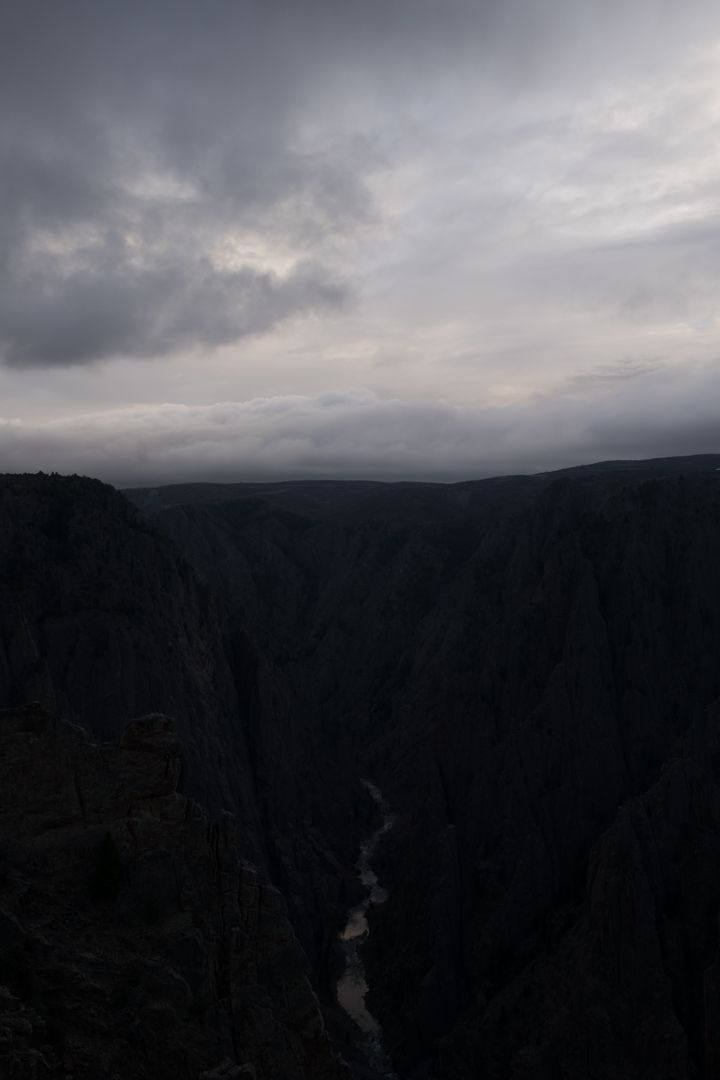
Original Raw Image
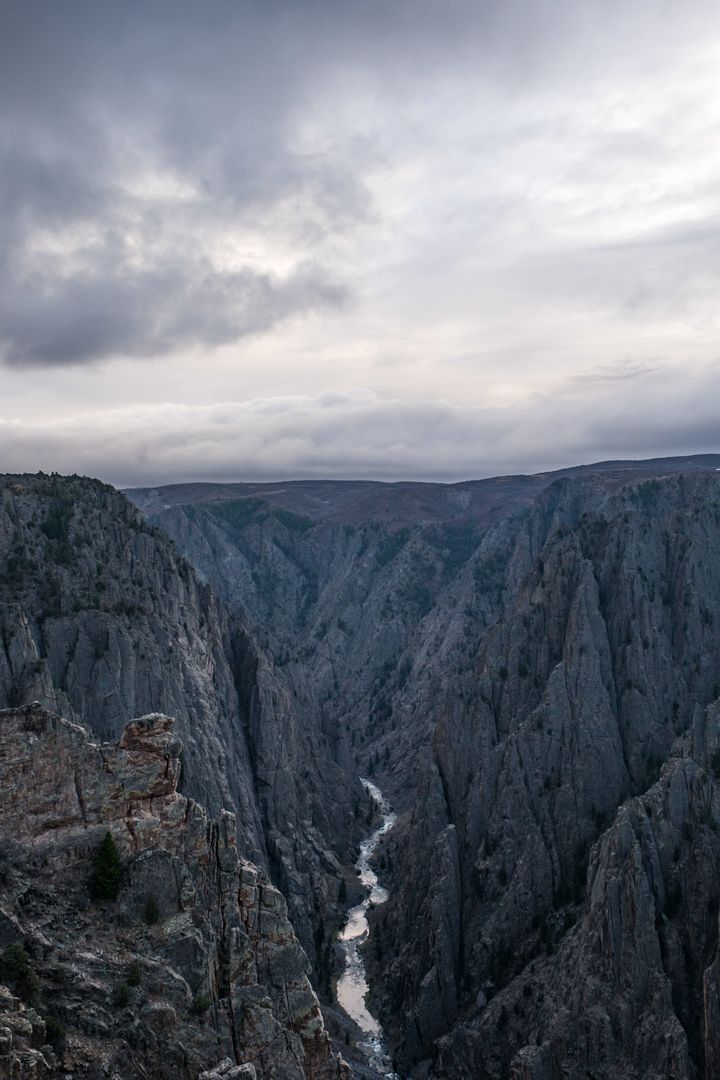
Image after editing
3) Use a tripod
There’s a reason why you’ll notice professionals using tripods. When they are back at their computer deciding which images are keepers, the first thing they look for is sharpness. If it’s not sharp, and there is not a good reason for the lack of sharpness (i.e. sometimes we want motion blur), then it goes into the trash. Nothing will help you get sharper images than using a sturdy tripod. Personally, I love Really Right Stuff tripods because they are light, compact, and really (really!) sturdy. I own both the TVC-34L Tripod + BH-55 LR Ballhead and the TVC-24L Tripod with BH-40 LR Ballhead, and love them both. They are expensive, but they are the best. Whatever you choose to use, bring one along and make good use of it and your “keeper” rate will improve dramatically – especially when dealing with tricky lighting scenarios (and also a must-have for the next tip.)
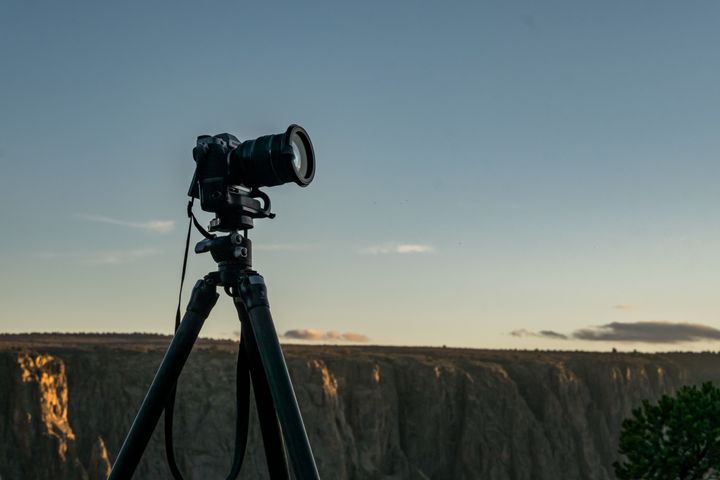
Use a sturdy tripod for the best images.
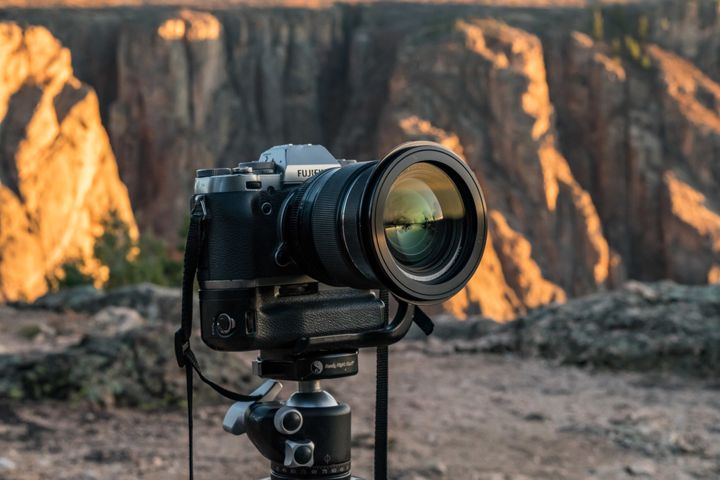
Fujifilm X-T1 set up for timelapse.
4) Bracket your images
Bracketing images means taking several images (usually three to five) of the same scene at different exposures (+ and – a normal exposure) to capture the entire dynamic range of a high contrast scene. These images can then be stitched together in post-production into an HDR (high dynamic range) image. Now, I know HDR has a bad reputation, mostly because of the heavy use of Photoshop tools which result in unrealistic looking images. But at its core, HDR images are simply meant to show the entire dynamic range of light and shadow when your camera is not able to capture it in a single exposure. This inability to capture the entire range in a single exposure – where the light at the surface is very bright but the shadows in the canyon are far darker – happens a lot in canyons. Either you will lose highlight detail (and blowout the sky) or shadow detail (unrecoverable shadow detail) when the range of contrast is greater than what the camera can handle. Many cameras today even have a built in HDR mode, which can be helpful for those new to bracketing images and stitching into HDR. So set up your tripod, shoot three or more bracketed images, use a soft touch in post-production, and you will get a nice image result from a tricky lighting situation.

5) Use a graduated neutral density filter
As is often the case in canyon photography, sometimes it’s important to balance the strong light with the dark shadows in a scene. In this case, a Graduated Neutral Density filter can help a lot. A GND filter sits on the front of your lens and has a gradual reduction in light from one end to the other. If you tone down the harsh sunlight at the top of the canyon (with the dark side of the filter), and leave the inner canyon alone (with the clear side), you will get a more balanced image, thereby helping your camera to retain detail in all areas. GND Filters come in all shapes, sizes, and variances, but my favorite is the Lee Filters 100 x 150mm 0.9 Soft-Edge Graduated Neutral Density Filter.
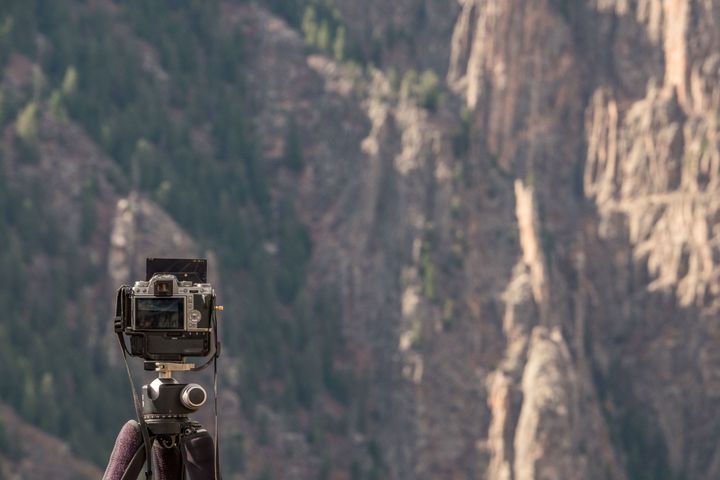
Fujifilm X-T1 set up with a neutral density filter
6) Cloudy weather and midday shooting are your friends
How you go about photographing canyons can often be anathema to how we usually photograph. We are told to look for the beautiful days filled with the soft and warm glow of the golden hour light. However, bright and sunny days and strong side lighting can make it difficult to photograph canyons well, as the light has a hard time reaching the inner canyon walls in a pleasing way. Instead, I look for cloudy days – which not only bring a nice moody feel to the photo, but also act as a diffuser for the sun – thereby eliminating strong contrast scenes. I also go out and photograph midday when the sun is high in the air, which is usually a no-no for photography, but for canyons, midday is one of the only times when the entire canyon can be lit by even light. So don’t be afraid of cloudy, overcast days or midday shooting – they are often your best choice for photographing canyons.
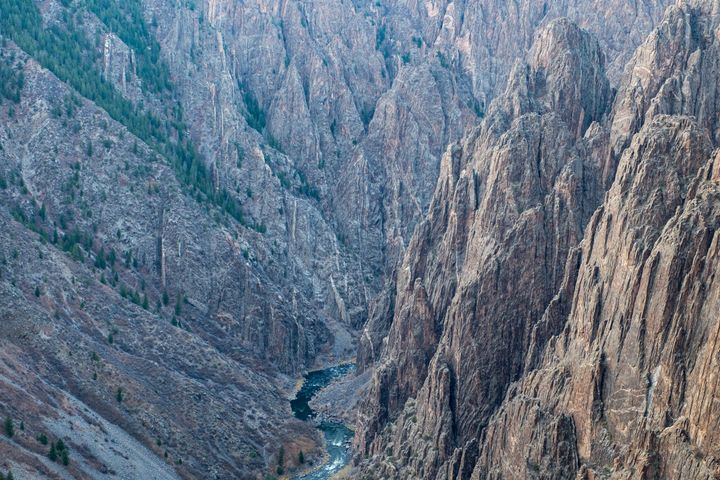
Cloudy weather and midday shooting are your friends
7) Push yourself (a bit)
I don’t love heights, and Black Canyon of the Gunnison has some of the steepest and sheerest cliff faces in North America which can be seen from almost every lookout in this national park. And there’s really only one way to show the depth and scale of the canyon and that is to get out close to the edge. For some of you, this may not be a big deal; for others, this is might be your greatest fear. Sometimes you must push yourself a bit to get better shots. Trust me, I didn’t love looking down on what would’ve been certain death had I toppled over, but my desire to represent this national park in the best way possible far supersedes my fear of heights. So go ahead and push yourself a bit – get near the edge – just be slow, strategic, and safe about it.

Close to the edge at the Painted Wall
8) Wait for a model
Sometimes you need people in a shot to show scale. Luckily, the national parks are popular places for visitors and usually, there is no lack of people to act as your model. I usually chat people up at lookouts and viewpoints, and I have made some really great friends in the national parks, while also capturing some cool photos thanks to them. For example, I saw the horseback riders (below) preparing to take off and I asked them if they wouldn’t mind if I took their photo as they were leaving, which led to a nice conversation about horseback riding in this park. I also talked with this gentleman at another viewpoint, also pictured below, who turned out to be from Ireland – one of my favorite places (I am Irish, after all.) We had a great conversation, and he let me take his photo looking back into the canyon. Don’t be afraid to chat people up and ask them if they wouldn’t mind being in your photo – adding people can help better tell the story of a place.
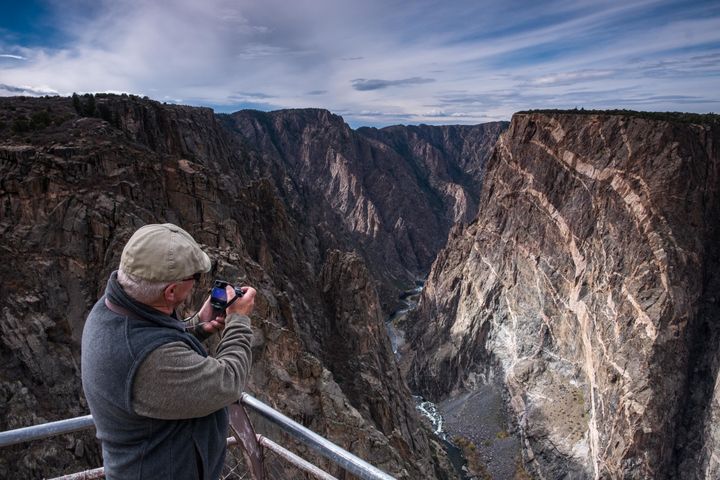
Making friends at the Painted Wall
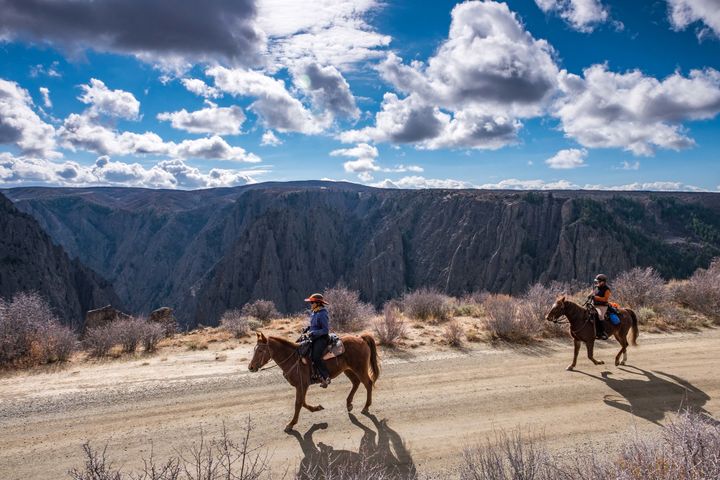
Equines take off for a rim ride to Deadhorse Trail
9) Get up high, if you can.
Varying the height of your camera is another time-tested technique used to capture interesting photos from unique vantage points. With canyon photography, this usually means stepping back and finding a higher place to climb up on to get a different angle. It’s not always possible to find higher ground beyond the top of a canyon, so in those instances I use a giant tripod. I have the Studio Assets MegaMast Carbon Fiber Camera Stand, which is a foldable tripod that raises to over 27ft! I can control my Fujifilm X-T1 Camera with my phone via wifi, which lets me get some really unique shots. What better way to show the depths of the canyon than getting a birds-eye-view? Plus, I bet no one else has that same shot.
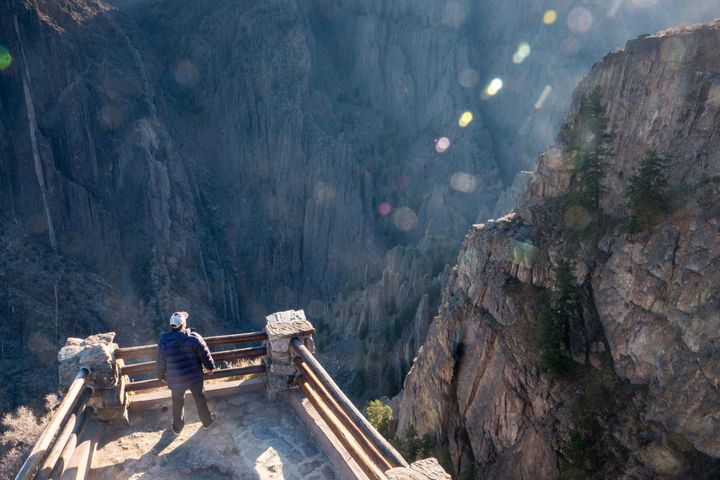
Shot with a 27ft. tripod
10) Blue hour is where it's at.
There’s a really special time in the day, called the “blue hour,” that will help you get some beautiful images of any canyon. Blue hour is essentially the time before sunrise and after sunset when the light hasn’t quite faded into night or day and the world is awash in a soft blue hue. You must act quickly, because the light changes fast at these times of the day. However, if you catch it at just the right time, you will be rewarded with a sublime photo.
With high contrast scenes and difficult lighting, photographing canyons can be quite tricky. But trust me when I say that it is not impossible to get a great shot of a canyon like Black Canyon of the Gunnison NP. Follow the tips and tricks above and your images of this (and any) canyon will dramatically improve.
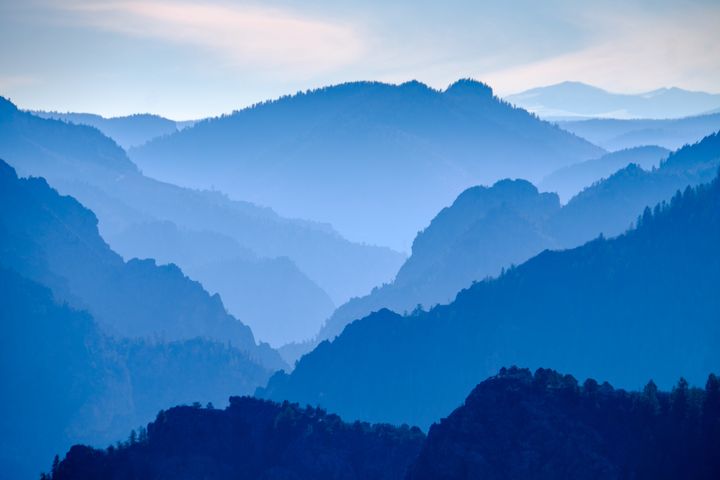
Blue hour at Black Canyon of the Gunnison NP
